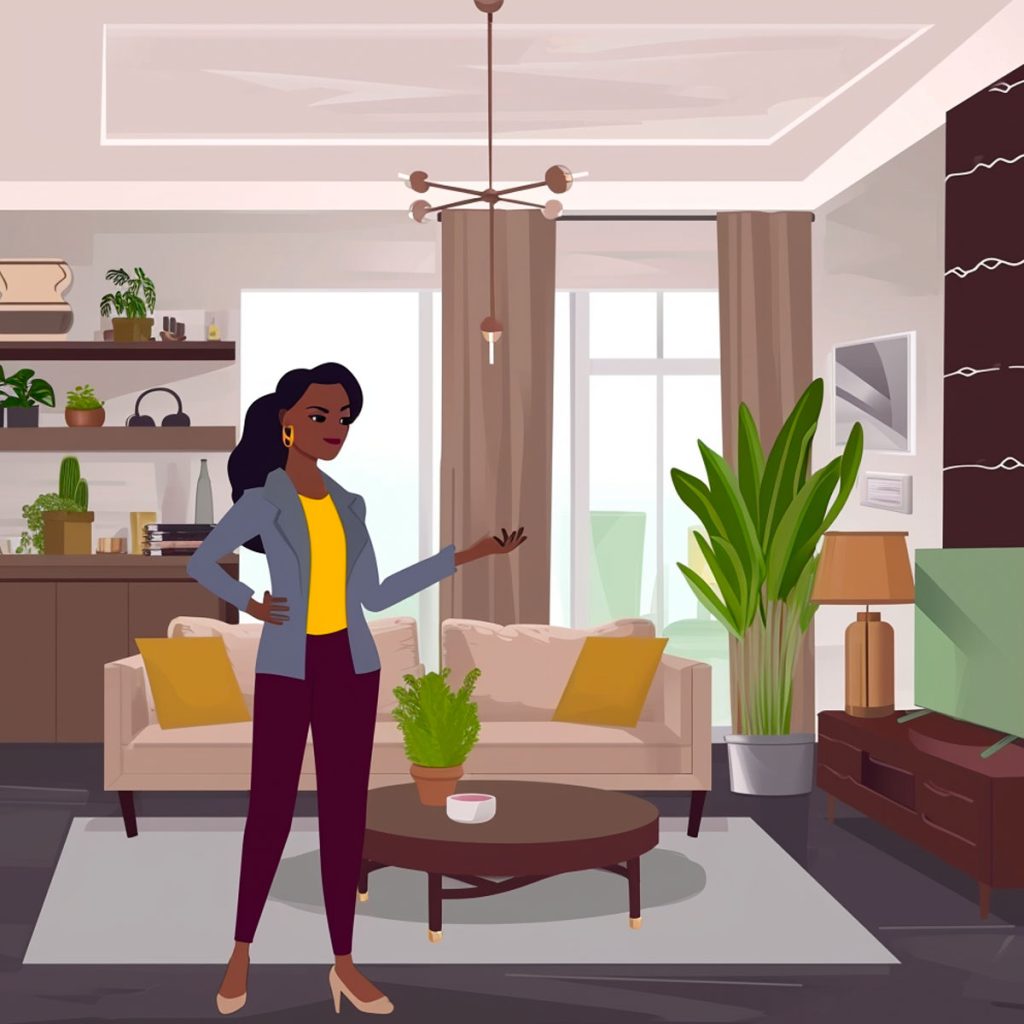Staging a home in Texas, much like in any competitive real estate market, is a crucial step in the process of selling a property. It goes beyond mere decoration; it’s about presenting the house in a way that highlights its strengths, downplays its weaknesses, and appeals to the broadest possible audience. A well-staged home can create a powerful first impression, enticing potential buyers to envision themselves living in the space. This visual allure can translate into tangible benefits, potentially leading to quicker sales and higher offers.

Real estate agents in Texas often emphasize staging as a key component of their selling strategy. The Lone Star State’s housing market can vary significantly from urban centers like Houston and Dallas to rural areas, and a properly staged home can stand out in any setting. Staging can range from simple decluttering and rearranging furniture to bringing in rented items and making minor renovations. Every detail counts, from the arrangement of pillows and artwork to the scent in the air, each playing a part in influencing a buyer’s decision.
The investment in staging is typically justified by the return it brings. Data suggests that homes that are staged before hitting the market sell faster and for better prices than those that are not. In today’s digital age, where online listings generate first impressions long before a foot is stepped through the door, the visual appeal of staging becomes even more crucial. High-quality photographs of a staged home can captivate potential buyers before they even visit, making staging an indispensable tool in the arsenal of sellers and real estate agents alike.
The Impact of Staging on Sales Price and Time on Market

Staging a home for sale often plays a pivotal role in its time on the market and can significantly influence the sales price. Proper staging can streamline the sale process and enhance the home’s appeal to buyers, potentially leading to a higher selling price.
Time on the Market
Houses that are professionally staged tend to spend less time on the market compared to non-staged homes. Statistics show that staged homes sell, on average, 33% faster than their non-staged counterparts. This reduction in time on the market is crucial as properties that linger can lead to potential buyers assuming there may be issues with the house or that it is overpriced.
- Average days on market for staged homes: 23 days
- Average days on market for non-staged homes: 34 days
Increasing Sales Price
Investment in staging has the potential to increase the selling price of a home. Sellers may see a return on investment from staging in the form of higher offers from buyers who are influenced by the enhanced appearance and perceived value of the property. Data indicates that staged homes can fetch sale prices that are 6-20% more than homes that were not staged.
- Increase in sales price due to staging: 6-20%
- Initial investment in staging: 0.5-3% of listing price
Potential Return on Investment (ROI): For every $100 invested in staging, the seller could see a return of $600 to $2,000 on the final selling price. This is a compelling factor for sellers aiming to achieve the highest possible price in the shortest amount of time.
Staging Essentials: Decluttering and Depersonalizing
Effective staging involves meticulously preparing a home to showcase its best features and potential. This process often entails extensive decluttering and strategic depersonalization to create a welcoming, neutral environment that allows potential buyers to envision themselves living in the space.
Decluttering Your Home
Decluttering is the first critical step in staging a home for sale. It is imperative to remove excess items which can make a space appear smaller and less appealing. Homeowners should focus on the following key areas:
- Living Areas: Simplify these spaces by removing unnecessary furniture and decor. Store away magazines, remote controls, and excess decorative pillows.
- Kitchens: Clear countertops, except for a few essential appliances, to enhance the perceived workspace. Organize cabinets and pantries, demonstrating ample storage capacity.
- Bathrooms: Keep countertops free of personal items like toothbrushes and toiletries. Tidy up linen closets and medicine cabinets to display orderly storage.
Depersonalization Techniques
Depersonalization is crucial in helping potential buyers picture themselves in the home. By reducing the presence of personal items, sellers can create a neutral canvas:
- Photographs: Remove family photos, awards, and personal achievements from walls and surfaces.
- Personal Collections: Pack away collections or hobby-related items that can be distracting and overly personal.
- Custom Decorations: Neutralize the space by replacing any bold or specific style decorations with more universally appealing ones.
Throughout the home, it is recommended to neutralize color schemes and personal accents in favor of a more universally appealing aesthetic. Potential buyers should be able to imagine their own belongings in the space, and that process is facilitated by presenting a clean, decluttered, and depersonalized environment.
Strategic Decorating and Functional Adjustments

When preparing a house for sale in Texas, it is essential to strategically decorate and make functional adjustments. These methods enhance the property’s appeal, helping potential buyers envision themselves living in the space.
Redecorating for Neutral Appeal
Redecorating a home for sale should focus on using neutral colors to widen its appeal. Walls painted in neutral tones, such as beige or light gray, create a blank canvas for buyers. This approach allows buyers to project their own vision of a home without the distraction of bold hues. Decor elements like artworks and fixtures should complement the color palette and not overpower the space. For example, a kitchen can be updated with new cabinet hardware in brushed nickel to add subtle elegance.
Furniture Arrangement and Accessory Use
Proper furniture arrangement can significantly affect a room’s perceived size and function. In the living room, arranging furniture to maximize space and facilitate conversation can make the room more inviting. Furniture should be placed in a way that highlights the room’s features, such as a fireplace or a beautiful window.
Accents and accessories play a crucial role in staging. A well-placed vase or a selection of tasteful books can add charm without clutter. Lighting should be ample yet warm to create a welcoming ambiance throughout the home. Adjustable lighting fixtures are a plus, allowing potential buyers to imagine how they can set the mood in each room. Accessories should be used sparingly; too many can make the space feel cluttered and smaller than it is.
Professional Staging and DIY Alternatives

When it comes to selling a house in Texas, presenting the property in its best light can make a significant difference. This section explores options for professional staging and provides practical advice for those who choose to prepare their home for sale without professional help.
Hiring a Professional Stager
A professional stager brings expertise in maximizing a home’s appeal to potential buyers. They assess each room’s strengths and create inviting spaces that highlight the property’s functionality and features. Professional stagers typically have access to a range of furniture and decor that suit various home styles, which can be an advantage over homeowners’ personal belongings.
Costs: The cost of hiring a professional stager in Texas varies based on the size and location of the home but can range from a few hundred to several thousand dollars. This investment often yields a higher sale price and a quicker sale.
Benefits: Enlisting the services of a professional can save the homeowner time and effort, as stagers efficiently manage the staging process from start to finish.
Do-It-Yourself Staging Tips
For those on a tighter budget or who prefer a hands-on approach, DIY staging can be a cost-effective alternative. Homeowners should focus on decluttering, depersonalizing spaces, and arranging furniture to showcase the home’s floor plan and features.
- Declutter: Remove personal items and excess furnishings.
- Clean: Deep-clean the house, including carpets and windows.
- Paint: Apply neutral paint colors to appeal to a wide range of buyers.
- Update: Fix any minor repairs and consider updates like new hardware.
- Highlight: Emphasize selling points, such as natural light or hardwood floors.
Considerations: While DIY staging can save on costs, it may be time-consuming and could require a significant amount of effort in preparing the home to meet buyers’ expectations.

Shardai Augustus is a dedicated and compassionate real estate professional specializing in the Houston and Katy Texas areas. With a solid background in secondary education as a math teacher spanning over 10 years, Shardai combines her love for teaching with a caring approach when assisting her real estate clients.
